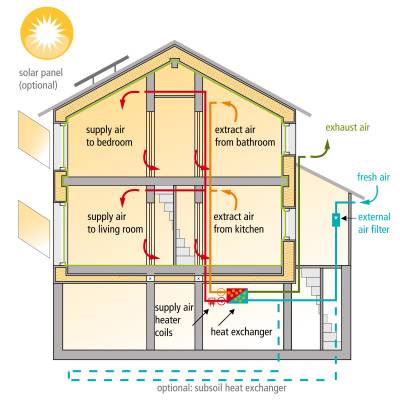Table of Contents
Building Services
Mechanical systems are needed to provide different services and amenities in every building e.g. the heat supply and distribution, the provision of hot water, ventilation for high-quality indoor air, and, depending on the climate and type of building – an active cooling system to achieve comfortable temperatures in summer. This page provides a brief overview of the different aspects and will direct you further reading on each topic.
Ventilation
Ventilation is needed in every building in order to ensure healthy and comfortable indoor conditions, it provides clean, pollen, dust-free air while eliminating excess moisture and odors where they occur. Good air quality can only be achieved if “used” air is regularly replaced by fresh air. Read here about different types of ventilation.
Mechanical ventilation with heat/ humidity recovery that ensures fresh air supply with high comfort and minimum heat loss is essential in every Passive House or EnerPHit project. Inside the heat exchanger, heat from the warm, stale air (extract air) is transferred onto the cold, incoming, outdoor air, thus reducing heat losses considerably. In the extreme summer heat, this system can even work in reverse, pre-cooling the fresh air that is supplied to the building. Depending on the efficiency of the heat exchanger, 90 percent of the heat can be transferred, allowing the supply air to come in at nearly room temperature.
Go to the overview of an article about ventilation on Passipeida.
Heating and hot water
As a highly energy efficient building, Passive House buildings have a very low space heating demand < 15 kWh/(m²a) and a very low heating load < 10 W/m². This makes is possible to use variety of simple and efficiency energy systems and sources to keep the building comfortably warm. Through informed design decisions and use of efficient systems there is also significant potential to reduce the energy demand for hot water provision.
Go to the overview of articles about heating DHW system on Passipedia.
Cooling
Depending on the climate, active cooling is needed to keep the building comfortably cool in summer. Applying the Passive House concept ensures that the cooling demand and cooling load are significantly lower than in a conventional building – allowing for simple and efficient cooling systems.
Here you can find some articles on the topic:
Renewable Energy supply
Renewable energy is the ideal complement to the energy efficiency of the Passive House Standard. In order to provide reliable guidance for this combination, the Passive House Institute has introduced categories for its building certification: in addition to the established “Passive House Classic”, there are Passive House Plus and Passive House Premium classes that require a minimum level of renewable energy supply.

